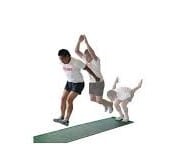
When contemplating a higher jump In Basketball, our minds are automatically geared towards dunking. That is perfectly understandable too.
However, jumping higher for the more conventional jump shot is equally as important when you are on a basketball court but not enough attention is paid to that particular facet of the game.
What you will find, for example, is that the demands on various parts of the body will vary, depending on what the desired outcome is when jumping higher on a basketball court.
Jumping higher to dunk dictates that you master the art of the running jump. Meanwhile jumping higher to complete a jump shot might require a little more emphasis on the standing jump.
Because the demands on the body vary between the two, you should adhere to a training programme that is more comprehensive and contributes to all of the leg muscle groups in equal measure.
Building Strength for Leg Muscles With Plyometrics
Plyometrics exercises are the most suitable for those among you who wish to increase your leg muscle strength for basketball. That is primarily because they help increase your body’s capacity to produce explosive power, which in turn helps you Jump Higher To Dunk.

All jumping activity involves the stretching and shortening of your muscles, which is where the focus also lies with plyometrics.
Here are Five Exercises that should contribute to a more efficient and more effective stretch-shortening cycle, while helping get you above the hoop, as it were!
1-
Drill Name: Front Box Jump
Drill Direction:
This exercise is a classic example of Jumping Plyometrics because it is a staple in most jump training regimens
Place a box that is about two-feet high in front of you
Start the drill standing in an upright position, with your feet about shoulder-width apart
Lower yourself into a squat position and swing your arms behind you
Explode upwards from the squat position, until your body is fully extended
Propel yourself into the air, with the assistance of your arms
Jump high enough for you to land safety on the two-foot box that you placed in front of you
Upon landing, try to absorb the total impact by flexing the knees a little
Depending on your athletic ability, you can jump back down from the box or step down from the box, if you feel that might be safer or more sensible
Perform the drill at a high intensity
You can add weight resistance (dumbbells) for more compelling results
Drill Time/Reps: 15 Minutes Per Session or 15 Reps
Drill Sessions: Two Sessions Per Week
2-
Drill Name: Side Box Jump
Drill Direction:
This exercise is outstanding for those wishing to Jump Higher In Volleyball, as there is an element of dynamisms associated with it - which is very much a must in the sport.
You could place a two-foot high box directly to your side (either on your left or right)
You could also place the same box to your side but slightly in front of you
If you are going for the first option, lower yourself into a squat position before exploding up into the air and sideways before landing safely on the box. Once you have landed you could either step down or you could jump back down from when you came.
If you are going for the second option, you should start the drill facing towards the box, before pushing sideways off one of your legs (either the right leg or the left leg).
You will then land on the ground with both feet, before performing a countermovement and jumping onto the box in front of you and landing safely on both feet. Step off the box and then start the drill again. With the latter, you could complete eight reps off the one leg before moving on to the opposite leg
Drill Time/Reps: 15 Minutes Per Session or 16 Reps
Drill Sessions: Two Sessions Per Week
3-
Drill Name: Weighted Lateral Jumps
Drill Direction:
Place seven cones in front of you
Start the drill in a standing position, before lowering yourself into a squatting position
In addition to exploding upward, you should also explode sideways
Depending on which side of the cone you start the drill, you should then land on the opposite of the cone and slightly in front of you
Keeping hopping forward until you have crossed the line for the final cone
You can perform this drill by taking off and landing on both feet
You can also perform this drill by taking off and landing on one foot, while alternating
You could also take off from one foot and land on two, while completing the course of the cones set out in front of you
Drill Time/Reps: 20 Minutes Per Session or 15 Reps
Drill Sessions: Two Sessions Per Week
4-
Drill Name: Lateral Skater Jumps
Drill Direction:
Start the drill by standing on either your left or right leg
Bend your hips and knees slightly, in preparation for an explosion upwards, forwards and slightly to the side
Land safely, preferably on the ball of your opposite foot
After absorbing the impact from landing on your opposite foot, take off from that leg and land on the other
You can sets cones or paint a 20m line in front of you, which will act as a guide
The key here is to imagine that you are skating, just without the skates...or roller blades, for that matter
Drill Time/Reps: 20 Minutes Per Session or 15 Reps
Drill Sessions: Two Sessions Per Week
5-
Drill Name: Scissor Jumps
Drill Direction:
Start this drill in a standing position, preferably in a room that has enough of a clearing above the head
Then lunge forward with either your right or left leg - it does not really matter which one you go with first because your legs will be alternating position throughout the drill
When you are ready, explode upwards into the air from what would effectively be a squatting position
While you are airborne, alternate the position of your legs, with the back foot landing in the forward lunging position, while the front foot lands behind you, also in that lunging position
Use your arms to help propel you further into the air and help balance your body when you land
Drill Time/Reps: 10-20 Minutes Per Session or 15 Reps
Drill Sessions: Four Sessions Per Week
How To improve Your Vertical Jump - Technique Improvement
Throughout these pages there is overwhelming emphasis on Improving Your Vertical Jump To Dunk. However, during the course of a basketball game, knowing How To Jump Higher for the standard jump shot is arguably more important and relevant.

Improving Vertical Jump Technique For Run-up and Take Off
You need to teach yourself how to transfer energy correctly when jumping.
Understanding that during the jump motion, you always start the runup by running or striding off the front half of your feet.
When you prepare for actual take-off, there needs to be a total weight transfer from your heels onto the balls of your feet.
During that transfer, you need to reconfigure your runup strides and effectively slow yourself enough to facilitate the transfer of that energy.
Before you take-off, you need to lower the weight of those hips and then extend out through the hips when pushing yourself into the air.
The emphasis should be on getting low enough to activate your glutes during the energy transfer when jumping. Yes, it is true that your calves and thighs all play a prominent role when jumping higher - but so too do Shoes That Make You Jump Higher. However, it is the activation of the glutes that is critical to getting you jumping higher, instead of just jumping forward.
The moment that you make that final step, just before propelling yourself into the air, your arms should be pushed behind your back. By the time you have already started to lower the weight of your hips, your arms should already be behind you.
Your arms, as much as is possible, should be moving in sync with your hips.
The point of this section was to place emphasis on the technique adopted during the runup and takeoff - which we feel has a more lasting impact on the quality of the vertical jump that you eventually produce.
Before you embark on a more adventurous runup, you can learn to perfect this facet of the technique by just focusing on those final two steps before takeoff. We are actually suggesting doing this as some form of drill.
So, find yourself an open space in which to train. This is something which could be done in the local park, at the local basketball court or even in the comfort of your own home.
Start by standing in an upright position and begin to visualise those final movements the body will make before taking off into the air.
Once you have that visual in your mind, shift to take the final two strides before leaping into the air. While you might not have the momentum often gained from an extensive runup, you can still execute those final two steps quite quickly. Start off slow, so that you get the transfer of energy right - from the heel, to the balls of the feet, to the hips! Drill all of that muscle memory into your mind first, before getting fancy.
When completing that countermovement and the transfer of energy associated with it, try to maintain a good posture that will help propel you forward and upwards. Don’t allow your body to rock backwards at any stage of this process.
If you are not confident about the entire motion, maybe start the drill by just focusing on the final two steps and the moment that you begin to push up, without actually taking off from the surface. Just push yourself down and then up again, as if you were dancing.
When you are satisfied with the technique up to this point, you can then progress with the drill and actually take off - again without using a run or actually dunking, blocking and spiking.
Difference Between Vertical Jump And A Standing Broad Jump
The Standing Broad Jump and Vertical Jump are equally dependent on the power output from the leg muscles. However, the differences in the contribution the legs and muscles make become more apparent when performing either one of the two jumps. Some of those differences are more subtle than others.
Hip Use For Vertical and Standing Broad Jump
The Standing Broad Jump demands about six percent more from your hips than a Vertical Jump. For the Standing Broad Jump, hip use accounts for 46 percent of the jump motion. For the Vertical Jump, hip use accounts for 40 percent of the jump motion.
Knee Use For Vertical and Standing Broad Jump
When compared to the demands from the hips and ankles, the knees contribute a mere 4 percent to the Standing Broad Jump motion - which means there is virtually no work to be done by the knees.
While the demands on the knees are also significantly less when completing a standard Vertical Jump, they still contribute to about 24 percent of the jump motion.
Ankle Use For Vertical and Standing Broad Jump
For the Standing Broad Jump it is all really in the ankles, which contribute about 50 percent to the entire jump motion.
The math is not as straightforward for the ankles when completing a Vertical Jump, where they still contribute about 35 percent to the entire jump motion.
Conclusion
Jumping higher In Basketball starts with a good training regimen, where Plyometrics normally feature prominently. The emphasis should be on plyometrics because they are normally ideal for increasing the strength in the lower half of your body, that is to say the legs.
While that is not the only strength training available for jumping, it is the best form of strength training for those seeking a better vertical.
The quest to jump higher should also include the quest to improve your technique.
Improving your technique hinges heavily on you understanding the biomechanics involved when jumping. Mastering the movement of jumping is actually more important than your power output when jumping.
An efficient jumper is always more likely to have success in the long-term than somebody who is heavily reliant on raw power and strength.
Hey, I’m Aleksandar and I am a Basketball freak! That is why I decided to create this blog. Teaching people How to dunk a basketball and How to Jump Higher in this sport or other related sports that require vertical jumping, is my specialty. If that’s your aim, then you have come to the right place.
